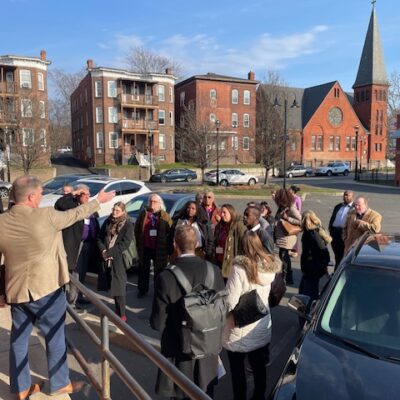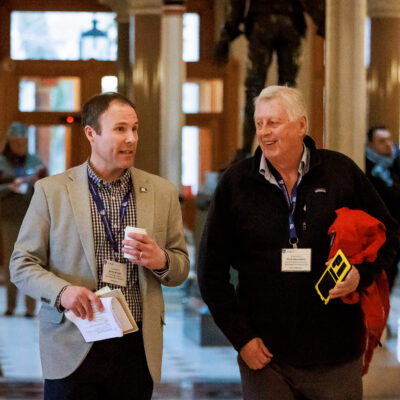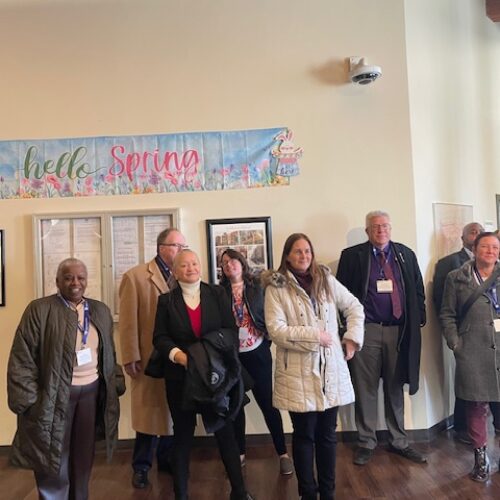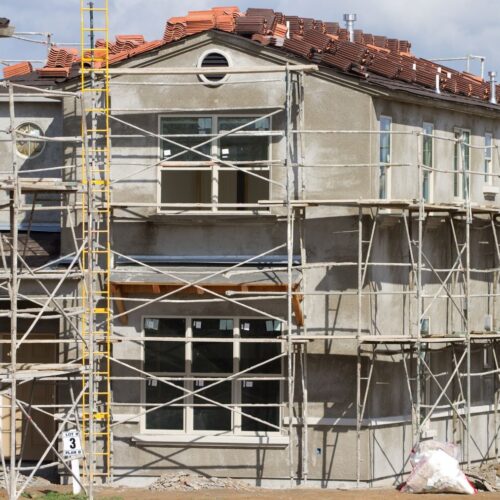Regional leaders discuss housing crisis at CSG East summit
A congregation of state officials gathered in Connecticut’s state capitol, March 22-23, 2024, for a two-day CSG East policy summit, hosted by Connecticut House Majority Leader Jason Rojas, to exchange ideas about one of the major problems affecting the East – housing affordability.
Policymakers from 9 states, 2 Canadian provinces, and the U.S. Virgin Islands met, broke bread together, and shared the challenges and solutions from their respective states during multiple hearing-style panels featuring esteemed experts in the field.

Cory Fellows leading a tour of Billings Forge
Connecticut Senate Majority Leader Bob Duff opened the program by welcoming attendees to a tour of Hartford’s Billings Forge affordable housing development, a 113-unit mixed-income apartment complex offering workforce development programs and after-school activities for residents. Cory Fellows, vice president of development at Preservation of Affordable Housing, led the tour and shared insights about how his team redeveloped the property. One point was made clear: affordable housing developments are not a blight on the neighborhood.
The tour was followed by a panel session on the financial costs and challenges facing developers who build affordable housing, where Fellows was joined by Brandon McGee, deputy commissioner of housing in Connecticut, and Nandini Natarajan, chief executive officer for Connecticut’s Housing Finance Authority. The discussion was moderated by Representative Eleni Kavros DeGraw, co-chair of Connecticut’s Planning and Development Committee and a 2023 Eastern Leadership Academy fellow. Natarajan recalled significant findings from a recently conducted housing needs assessment, and noted the challenges of securing land that is free of contaminants and ready for development. After highlighting the Department of Housing’s efforts to educate constituents on tools for finding affordable housing, McGee emphasized inadequate infrastructure as an obstacle to building more housing in municipalities that would welcome new development. At the dinner reception that followed, Connecticut Housing Commissioner Seila Mosquera-Bruno briefly highlighted key housing initiatives in the state during her welcoming remarks.
Despite pouring rain, policy sessions started early on Saturday morning as legislators and panelists filed into Hartford’s legislative office building. Andrew Aurand, senior vice president of research at the National Low Income Housing Coalition, gave a keynote address highlighting state-level data from The Gap and Out of Reach reports, making it clear that new supply and public investment must be part of state strategies to lift the burdens of housing affordability for residents.
Following the keynote, participants dived right into the morning agenda. In the first panel on Building Solutions, Vishaan Chakrabarti, founder and creative director for Practice for Architecture and Urbanism, elaborated on the data and thinking behind his recent New York Times piece about building 500,000 new homes in New York City. “Everyone thinks their neighborhood is full; it’s not,” he said during the panel. Jennifer Raitt, executive director for the Northern Middlesex Council of Governments, also discussed recent zoning reforms in Massachusetts and her work on the Housing Supply Accelerator, a partnership between the American Planning Association and National League of Cities, and Governor Healey’s Commission on Unlocking Housing Production. Ben Frost, deputy executive director for New Hampshire Housing, discussed how to build new housing in places where infrastructure is largely absent, particularly in rural communities, and ways to overcome local resistance to new development. Frost also helps to lead the project team for the New Hampshire Zoning Atlas.

Lawmakers exchange ideas between sessions at the capitol
Connecticut Governor Ned Lamont joined the summit to discuss his executive housing strategy, telling lawmakers that increasing the supply of housing was a priority for his administration. Despite high interest rates and elevated construction costs, the governor is focused on incentivizing the production of more housing. He is working with towns to build in “pre-zoned” areas designated locally for new development, and is working with developers to overcome financing gaps and streamline the processes that have resulted in costly delays. On infrastructure, his administration is working to modernize septic systems and increase transit-oriented development. When asked by MPP Matthew Rae from Ontario about building support for a pro-housing agenda, Lamont noted both the business and social incentives that are tied to building more housing, and how this consensus lays a good foundation for progress.
Saturday’s second panel on Zoning and Land Use Reforms opened with Toccarra Nicole Thomas, director of land use and development at SmartGrowth America, outlining the historical use of zoning for racial segregation and how zoning laws have led to sprawling cities. “Zoning is the invisible structure that dictates everything in the built environment,” she said. Sara Bronin, founder of the National Zoning Atlas, described how policymakers can use the atlas, the significant findings that have already been used to influence state policies, and advocated for a push towards form-based codes to make understanding the laws easier. The final panelist, John Infranca, a visiting professor at Yale Law School, leads the project team for the Massachusetts Zoning Atlas. He elaborated on the effectiveness of state-level land use reforms, including Mount Laurel in New Jersey, Chapter 40B in Massachusetts, and recent accessory dwelling unit laws in California. Following this session, there was a break for lunch and networking.
The final panel on Creating a State-Level Housing Strategy began with an impassioned testimony by Reverand Eric Dobson, deputy director of the Fair Share Housing Center in New Jersey, whose agency enforces the Mount Laurel Doctrine, a statewide framework that has led to some of the highest rates of affordable housing production in the country. “Since 2015, we produced over 21,000 new deed-restricted affordable units,” he said. Next, Jennifer Gottlieb Elazhari, a director at the U.S. Department of Housing and Urban Development, covered a range of federal programs available to states and noted that many states do not take full advantage of funding available through the Project Based Voucher Program. Moses Gates, vice president of housing at the Regional Plan Association, closed the panel with a call for greater transparency around zoning laws and regulations to foster a better understanding about the current state of restrictions for both policymakers and constituents.
Momentum is not slowing down for state officials tackling the housing crisis in the East. Conversations and connections have continued since the summit, and CSG East will continue to facilitate the exchange of ideas on this critical issue. Our next housing-related discussions will take place at the 63rd Annual Meeting in Baltimore, July 28-31, 2024. During this meeting, panel sessions will cover:
- Housing markets and policy innovations
- Climate-friendly conversions and sustainable housing designs
- State-funded rental assistance and eviction diversion
- Transit-oriented development
- Missing middle housing for walkable communities
There will also be a 2-hour bus tour of Baltimore, led by Baltimore City’s Department of Housing and Community Development, covering the housing programs, initiatives, and policies that have been instrumental to unlocking new housing supply.
Materials from the Housing Policy Summit in Hartford – including the agenda, speaker bios, attendance list, photos, and slide decks – can be found here.
For more information, reach out to CSG East’s Housing Policy Analyst, Joseph Shiovitz at jshiovitz@csg.org.











